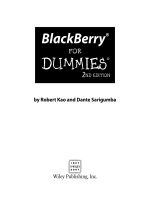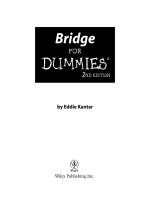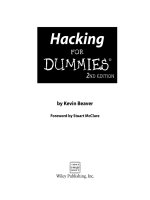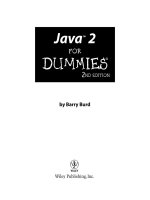Guitar For Dummies (2nd Ed)
Bạn đang xem bản rút gọn của tài liệu. Xem và tải ngay bản đầy đủ của tài liệu tại đây (7.03 MB, 411 trang )
Guitar
FOR
DUMmIES
2ND
‰
EDITION
Guitar
FOR
DUMmIES
2ND
‰
EDITION
by Mark Phillips and Jon Chappell
Guitar For Dummies®, 2nd Edition
Published by
Wiley Publishing, Inc.
111 River St.
Hoboken, NJ 07030-5774
www.wiley.com
Copyright © 2006 by Wiley Publishing, Inc., Indianapolis, Indiana
Published simultaneously in Canada
No part of this publication may be reproduced, stored in a retrieval system, or transmitted in any form
or by any means, electronic, mechanical, photocopying, recording, scanning, or otherwise, except as
permitted under Sections 107 or 108 of the 1976 United States Copyright Act, without either the prior
written permission of the Publisher, or authorization through payment of the appropriate per-copy
fee to the Copyright Clearance Center, 222 Rosewood Drive, Danvers, MA 01923, 978-750-8400, fax
978-646-8600. Requests to the Publisher for permission should be addressed to the Legal Department,
Wiley Publishing, Inc., 10475 Crosspoint Blvd., Indianapolis, IN 46256, 317-572-3447, fax 317-572-4355,
or online at />Trademarks: Wiley, the Wiley Publishing logo, For Dummies, the Dummies Man logo, A Reference for the
Rest of Us!, The Dummies Way, Dummies Daily, The Fun and Easy Way, Dummies.com and related trade
dress are trademarks or registered trademarks of John Wiley & Sons, Inc. and/or its affiliates in the United
States and other countries, and may not be used without written permission. All other trademarks are the
property of their respective owners. Wiley Publishing, Inc., is not associated with any product or vendor
mentioned in this book.
LIMIT OF LIABILITY/DISCLAIMER OF WARRANTY: THE PUBLISHER AND THE AUTHOR MAKE NO REPRESENTATIONS OR WARRANTIES WITH RESPECT TO THE ACCURACY OR COMPLETENESS OF THE CONTENTS OF THIS WORK AND SPECIFICALLY DISCLAIM ALL WARRANTIES, INCLUDING WITHOUT
LIMITATION WARRANTIES OF FITNESS FOR A PARTICULAR PURPOSE. NO WARRANTY MAY BE CREATED OR EXTENDED BY SALES OR PROMOTIONAL MATERIALS. THE ADVICE AND STRATEGIES CONTAINED HEREIN MAY NOT BE SUITABLE FOR EVERY SITUATION. THIS WORK IS SOLD WITH THE
UNDERSTANDING THAT THE PUBLISHER IS NOT ENGAGED IN RENDERING LEGAL, ACCOUNTING, OR
OTHER PROFESSIONAL SERVICES. IF PROFESSIONAL ASSISTANCE IS REQUIRED, THE SERVICES OF A
COMPETENT PROFESSIONAL PERSON SHOULD BE SOUGHT. NEITHER THE PUBLISHER NOR THE
AUTHOR SHALL BE LIABLE FOR DAMAGES ARISING HEREFROM. THE FACT THAT AN ORGANIZATION
OR WEBSITE IS REFERRED TO IN THIS WORK AS A CITATION AND/OR A POTENTIAL SOURCE OF FURTHER INFORMATION DOES NOT MEAN THAT THE AUTHOR OR THE PUBLISHER ENDORSES THE INFORMATION THE ORGANIZATION OR WEBSITE MAY PROVIDE OR RECOMMENDATIONS IT MAY MAKE.
FURTHER, READERS SHOULD BE AWARE THAT INTERNET WEBSITES LISTED IN THIS WORK MAY HAVE
CHANGED OR DISAPPEARED BETWEEN WHEN THIS WORK WAS WRITTEN AND WHEN IT IS READ.
For general information on our other products and services, please contact our Customer Care
Department within the U.S. at 800-762-2974, outside the U.S. at 317-572-3993, or fax 317-572-4002.
For technical support, please visit www.wiley.com/techsupport.
Wiley also publishes its books in a variety of electronic formats. Some content that appears in print may
not be available in electronic books.
Library of Congress Control Number: 2005932590
ISBN-13: 978-0-7645-9904-0
ISBN-10: 0-7645-9904-6
Manufactured in the United States of America
10 9 8 7 6 5 4 3 2 1
2B/SZ/QZ/QV/IN
About the Authors
Mark Phillips is a guitarist, arranger, and editor with more than 30 years in
the music publishing field. He earned his bachelor’s degree in music theory
from Case Western Reserve University, where he received the Carolyn Neff
Award for scholastic excellence, and his master’s degree in music theory from
Northwestern University, where he was elected to Pi Kappa Lambda, the most
prestigious U.S. honor society for college and university music students. While
working toward a doctorate in music theory at Northwestern, Phillips taught
classes in theory, ear-training, sight-singing, counterpoint, and guitar.
During the 1970s and early ’80s, Phillips was Director of Popular Music at
Warner Bros. Publications, where he edited and arranged the songbooks of
such artists as Neil Young, James Taylor, the Eagles, and Led Zeppelin. Since
the mid-’80s he has served as Director of Music and Director of Publications
at Cherry Lane Music, where he has edited or arranged the songbooks of
such artists as John Denver, Van Halen, Guns N’ Roses, and Metallica, and has
served as Music Editor of the magazines Guitar and Guitar One.
Phillips is the author of several books on musical subjects, including Metallica
Riff by Riff, Sight-Sing Any Melody Instantly, and Sight-Read Any Rhythm Instantly.
In his non-musical life, Phillips is the author/publisher of a series of “fun” high
school English textbooks, including The Wizard of Oz Vocabulary Builder, The
Pinocchio Intermediate Vocabulary Builder, and Tarzan and Jane’s Guide to
Grammar. For the reference value of his numerous publications, Phillips is
profiled in Who’s Who in America.
Jon Chappell is a multistyle guitarist, transcriber, and arranger. He attended
Carnegie-Mellon University, where he studied with Carlos Barbosa-Lima, and
he then went on to earn his master’s degree in composition from DePaul
University, where he also taught theory and ear training. He was formerly
Editor-in-Chief of Guitar magazine, Technical Editor of Guitar Shop Magazine,
and Musicologist for Guitarra, a classical magazine. He has played and
recorded with Pat Benatar, Judy Collins, Graham Nash, and Gunther Schuller,
and he has contributed numerous musical pieces to film and TV. Some of
these include Northern Exposure, Walker, Texas Ranger, Guiding Light, and
the feature film Bleeding Hearts directed by actor-dancer Gregory Hines. In
1990, he became Associate Music Director of Cherry Lane Music where he has
transcribed, edited, and arranged the music of Joe Satriani, Steve Vai, Steve
Morse, Mike Stern, and Eddie Van Halen, among others. He has more than
a dozen method books to his name, and is the author of Rock Guitar For
Dummies and the textbook The Recording Guitarist — A Guide for Home and
Studio, published by Hal Leonard.
Dedication
Mark Phillips: For my wife, Debbie, and my children, Tara, Jake, and Rachel.
Jon Chappell: For my wife, Mary, and my children, Jennifer, Katie, Lauren,
and Ryan.
Authors’ Acknowledgments
The authors gratefully acknowledge the folks at Wiley Publishing, Inc.:
Tracy Boggier, Mike Baker, and Jen Bingham.
Special thanks to Woytek and Krystyna Rynczak of WR Music Service for the
music typesetting, and to Brian McConnon of Steinberg for the CD recording
software, Cubase SX and Nuendo.
Publisher’s Acknowledgments
We’re proud of this book; please send us your comments through our Dummies online registration
form located at www.dummies.com/register/.
Some of the people who helped bring this book to market include the following:
Acquisitions, Editorial, and
Media Development
Project Editor: Mike Baker
(Previous Edition: Kyle Looper)
Acquisitions Editor: Tracy Boggier
Copy Editor: Jennifer Bingham
Composition Services
Project Coordinator: Adrienne Martinez
Layout and Graphics: Carl Byers,
Lauren Goddard, Joyce Haughey,
Barbara Moore, Barry Offringa,
Lynsey Osborn, Rashell Smith, Erin Zeltner
Editorial Program Assistant: Courtney Allen
Proofreaders: Leeann Harney,
Carl William Pierce, Shannon Ramsey,
Charles Spencer
Technical Reviewer: Rod E. Schindler
Indexer: Rebecca R. Plunkett
Media Development Specialist: Laura Moss
Special Help: Tim Borek, Kit Malone
(Previous Edition: William A. Barton)
Editorial Manager: Christine Meloy Beck
Media Development Manager:
Laura VanWinkle
Editorial Assistants: Nadine Bell, Hanna Scott
Cover Photos: Jon Chappell
Cartoons: Rich Tennant
(www.the5thwave.com)
Publishing and Editorial for Consumer Dummies
Diane Graves Steele, Vice President and Publisher, Consumer Dummies
Joyce Pepple, Acquisitions Director, Consumer Dummies
Kristin A. Cocks, Product Development Director, Consumer Dummies
Michael Spring, Vice President and Publisher, Travel
Kelly Regan, Editorial Director, Travel
Publishing for Technology Dummies
Andy Cummings, Vice President and Publisher, Dummies Technology/General User
Composition Services
Gerry Fahey, Vice President of Production Services
Debbie Stailey, Director of Composition Services
Contents at a Glance
Introduction ................................................................1
Part I: So You Wanna Play Guitar .................................9
Chapter 1: Guitar 101 ......................................................................................................11
Chapter 2: Turn On, Tune In ..........................................................................................19
Chapter 3: Ready, Set . . . Not Yet: Developing the Tools and Skills to Play .............27
Part II: So Start Playing: The Basics ...........................39
Chapter 4: The Easiest Way to Play: Basic Major and Minor Chords .......................41
Chapter 5: Playing Melodies without Reading Music! .................................................61
Chapter 6: Adding Some Spice: Basic 7th Chords .......................................................71
Part III: Beyond the Basics: Starting to Sound Cool ......87
Chapter 7: Playing Melodies in Position and in Double-Stops ...................................89
Chapter 8: Stretching Out: Barre Chords ...................................................................103
Chapter 9: Special Articulation: Making the Guitar Talk ..........................................127
Part IV: A Cornucopia of Styles .................................153
Chapter 10: Rock ...........................................................................................................155
Chapter 11: Blues ..........................................................................................................183
Chapter 12: Folk .............................................................................................................207
Chapter 13: Classical .....................................................................................................231
Chapter 14: Jazz .............................................................................................................247
Part V: Purchasing and Caring for Your Guitar ...........261
Chapter 15: Perfectly Good Guitars ............................................................................263
Chapter 16: Guitar Accessories ...................................................................................279
Chapter 17: Getting Strung Along: Changing Strings ................................................295
Chapter 18: Staying Fit: Basic Maintenance and Repairs .........................................307
Part VI: The Part of Tens ..........................................325
Chapter 19: Ten Guitarists You Should Know ............................................................327
Chapter 20: Ten Guitars You Should Know ................................................................333
Part VII: Appendixes ................................................337
Appendix A: How to Read Music .................................................................................339
Appendix B: 96 Common Chords ................................................................................351
Appendix C: How to Use the CD ..................................................................................355
Index .......................................................................365
Table of Contents
Introduction .................................................................1
About This Book ..............................................................................................1
Finding a guitar ......................................................................................1
Playing the guitar ..................................................................................2
Caring for your guitar ...........................................................................3
Not-So-Foolish Assumptions ..........................................................................3
What You’re Not to Read ................................................................................3
Conventions We Use in This Book ................................................................4
How This Book Is Organized ..........................................................................4
Part I: So You Wanna Play Guitar .........................................................5
Part II: So Start Playing: The Basics ....................................................5
Part III: Beyond the Basics: Starting to Sound Cool ..........................6
Part IV: A Cornucopia of Styles ............................................................6
Part V: Purchasing and Caring for Your Guitar ..................................6
Part VI: The Part of Tens ......................................................................7
Part VII: Appendixes ..............................................................................7
Icons Used in This Book .................................................................................7
Where to Go from Here ...................................................................................8
Part I: So You Wanna Play Guitar .................................9
Chapter 1: Guitar 101 . . . . . . . . . . . . . . . . . . . . . . . . . . . . . . . . . . . . . . . . .11
Anatomy of a Guitar ......................................................................................11
How Guitars Work .........................................................................................14
String vibration and string length .....................................................15
Using both hands to make a sound ...................................................15
Frets and half steps .............................................................................16
Pickups .................................................................................................16
Chapter 2: Turn On, Tune In . . . . . . . . . . . . . . . . . . . . . . . . . . . . . . . . . . . .19
Counting on Your Strings and Frets ............................................................19
Everything’s Relative: Tuning the Guitar to Itself .....................................20
The fifth-fret method ...........................................................................20
In Deference to a Reference: Tuning to a Fixed Source ............................22
Taking a turn at the piano ..................................................................23
Tuning your guitar with a pitch pipe ................................................24
Sinking your teeth into the tuning fork .............................................24
Experiencing the electronic tuner .....................................................25
Using your CD ......................................................................................26
xii
Guitar For Dummies, 2nd Edition
Chapter 3: Ready, Set . . . Not Yet: Developing the Tools
and Skills to Play . . . . . . . . . . . . . . . . . . . . . . . . . . . . . . . . . . . . . . . . . . . .27
Hand Position and Posture ..........................................................................27
Settling in to a sitting position ...........................................................28
Standing position .................................................................................29
Left-hand position: Fretting made easy ............................................30
Right-hand position .............................................................................32
You Don’t Have to Read Music to Understand Guitar Notation ..............34
Getting by with a little help from a chord diagram .........................34
Reading rhythm slashes .....................................................................36
Taking a look at tablature ...................................................................36
How to Play a Chord .....................................................................................37
Fingering a chord .................................................................................37
Avoiding buzzes ...................................................................................38
Part II: So Start Playing: The Basics ............................39
Chapter 4: The Easiest Way to Play:
Basic Major and Minor Chords . . . . . . . . . . . . . . . . . . . . . . . . . . . . . . . .41
Playing Chords in the A Family ...................................................................42
Fingering A-family chords ...................................................................42
Strumming A-family chords ................................................................43
Playing Chords in the D Family ...................................................................45
Fingering D-family chords ..................................................................46
Strumming D-family chords ...............................................................47
Playing Chords in the G Family ...................................................................48
Fingering G-family chords ..................................................................48
Strumming G-family chords ...............................................................48
Playing Chords in the C Family ...................................................................49
Fingering C-family chords ...................................................................50
Strumming C-family chords ................................................................50
Playing Songs with Basic Major and Minor Chords ..................................51
Having Fun with Basic Major and Minor Chords:
The “Oldies” Progression .........................................................................58
Chapter 5: Playing Melodies without Reading Music! . . . . . . . . . . . .61
Reading Tablature While Listening to the CD ............................................62
Top or bottom? ....................................................................................62
Right or left? .........................................................................................63
Getting a Grip on Left-Hand Fingering ........................................................64
Using Alternate Picking ................................................................................64
Playing Songs with Simple Melodies ...........................................................66
Table of Contents
Chapter 6: Adding Some Spice: Basic 7th Chords . . . . . . . . . . . . . . . .71
Dominant 7th Chords ...................................................................................72
D7, G7, and C7 ......................................................................................72
E7 and A7 ..............................................................................................73
E7 (four-finger version) and B7 .........................................................74
Minor 7th Chords — Dm7, Em7, and Am7 .................................................75
Major 7th Chords — Cmaj7, Fmaj7, Amaj7, and Dmaj7 ............................76
Playing Songs with 7th Chords ....................................................................77
Fun with 7th Chords: The 12-Bar Blues ......................................................84
Playing the 12-bar blues .....................................................................84
Writing your own blues song .............................................................85
Part III: Beyond the Basics: Starting to Sound Cool ......87
Chapter 7: Playing Melodies in Position and in Double-Stops . . . . .89
Playing in Position ........................................................................................89
Playing in position versus playing with open strings .....................90
Playing exercises in position .............................................................90
Shifting positions .................................................................................92
Building strength and dexterity by playing in position ..................93
Double-Stops ..................................................................................................95
Understanding double-stops ..............................................................95
Playing exercises in double-stops .....................................................95
Playing Songs in Position and in Double-Stops .........................................97
Chapter 8: Stretching Out: Barre Chords . . . . . . . . . . . . . . . . . . . . . . .103
Playing Major Barre Chords Based on E ..................................................103
Finding the right fret .........................................................................105
Playing progressions using major
barre chords based on E ...............................................................106
Playing Minor, Dominant 7th, and
Minor 7th Barre Chords Based on E ......................................................107
Minor chords ......................................................................................108
Dominant 7th chords ........................................................................109
Minor 7th chords ...............................................................................110
Playing Major Barre Chords Based on A ..................................................111
Fingering the A-based major barre chord ......................................112
Finding the right fret .........................................................................113
Progressions using A-based major barre chords ..........................113
Playing Minor, Dominant 7th, Minor 7th, and
Major 7th Barre Chords Based on A .....................................................115
Minor chords ......................................................................................115
Dominant 7th chords ........................................................................116
Minor 7th chords ...............................................................................117
Major 7th chords ...............................................................................117
xiii
xiv
Guitar For Dummies, 2nd Edition
Wailing on Power Chords ...........................................................................119
Fingering power chords ....................................................................119
How you use power chords .............................................................122
Playing Songs with Barre Chords and Power Chords .............................123
Chapter 9: Special Articulation: Making the Guitar Talk . . . . . . . . .127
Getting the Hang of Hammer-Ons .............................................................128
Playing a hammer-on ........................................................................128
Getting idiomatic with hammer-ons ...............................................130
Getting Playful with Pull-Offs .....................................................................132
Playing pull-offs .................................................................................132
Getting idiomatic with pull-offs .......................................................135
Getting Slippery with Slides .......................................................................135
Playing slides .....................................................................................136
Playing idiomatic licks using slides ................................................138
Getting the Bends ........................................................................................139
Playing bends .....................................................................................140
Getting idiomatic with bends ...........................................................142
Varying Your Sound with Vibrato ..............................................................145
Getting Mellow with Muting .......................................................................147
Creating a thick, chunky sound as an effect ..................................148
Preventing unwanted string noise ..................................................149
Playing idiomatic licks using muting ..............................................149
Playing a Song with Varied Articulation ...................................................151
Part IV: A Cornucopia of Styles .................................153
Chapter 10: Rock . . . . . . . . . . . . . . . . . . . . . . . . . . . . . . . . . . . . . . . . . . . .155
Classic Rock ’n’ Roll ....................................................................................155
Rhythm guitar ....................................................................................156
Lead guitar .........................................................................................159
Modern Rock ................................................................................................169
Sus and add chords ...........................................................................169
Slash chords .......................................................................................170
Alternate tunings ...............................................................................172
Country-rock and Southern-rock lead ............................................174
Playing Songs in the Rock Style .................................................................177
Chapter 11: Blues . . . . . . . . . . . . . . . . . . . . . . . . . . . . . . . . . . . . . . . . . . .183
Electric Blues ...............................................................................................184
Blues rhythm guitar ..........................................................................184
Blues lead guitar ................................................................................189
Table of Contents
Acoustic Blues .............................................................................................197
General concepts ...............................................................................197
Specific techniques ...........................................................................200
Turnarounds ......................................................................................202
Playing Blues Songs ....................................................................................204
Chapter 12: Folk . . . . . . . . . . . . . . . . . . . . . . . . . . . . . . . . . . . . . . . . . . . . .207
Playing Fingerstyle ......................................................................................207
Fingerstyle technique .......................................................................208
Right-hand position ...........................................................................208
Using the Capo ............................................................................................210
Arpeggio Style ..............................................................................................212
Playing arpeggio style .......................................................................212
“Lullaby” pattern ...............................................................................213
Thumb-Brush Style .....................................................................................214
Simple thumb-brush ..........................................................................214
Thumb-brush-up ................................................................................215
Carter Style ..................................................................................................215
Travis Picking ..............................................................................................216
Playing the pattern ............................................................................217
Accompaniment style .......................................................................219
Solo style ............................................................................................220
Open tuning ........................................................................................220
Playing Folk Songs .......................................................................................222
Chapter 13: Classical . . . . . . . . . . . . . . . . . . . . . . . . . . . . . . . . . . . . . . . .231
Getting Ready to Play Classical Guitar .....................................................232
How to sit ...........................................................................................232
The right hand ...................................................................................233
Left-hand position .............................................................................235
Free Strokes and Rest Strokes ...................................................................237
Playing free strokes ...........................................................................237
Playing rest strokes ...........................................................................238
Arpeggio Style and Contrapuntal Style ....................................................240
Combining free strokes and rest strokes in arpeggios .................240
Point/counterpoint ............................................................................240
Playing Classical Pieces ..............................................................................242
Chapter 14: Jazz . . . . . . . . . . . . . . . . . . . . . . . . . . . . . . . . . . . . . . . . . . . .247
Introducing a Whole New Harmony ..........................................................248
Extended chords ................................................................................248
Altered chords ...................................................................................249
xv
xvi
Guitar For Dummies, 2nd Edition
Rhythm Comping ........................................................................................249
Inside chords .....................................................................................249
Outside chords ..................................................................................250
Full chords ..........................................................................................252
Playing Solo: Chord-Melody Style .............................................................253
Making substitutions ........................................................................253
Faking it with three chords ..............................................................254
Taking the Lead: Jazz Melody ....................................................................254
Scales with altered tones ..................................................................255
Approaching target notes .................................................................256
Making melodies from arpeggiated chords ....................................256
Playing Jazz Songs .......................................................................................257
Part V: Purchasing and Caring for Your Guitar ...........261
Chapter 15: Perfectly Good Guitars . . . . . . . . . . . . . . . . . . . . . . . . . . . .263
Before Breaking Out Your Wallet ...............................................................264
Beginner Guitars ..........................................................................................265
Models for a Particular Style .....................................................................267
The Second (And Third . . .) Guitars .........................................................268
Construction ......................................................................................270
Materials .............................................................................................271
Workmanship .....................................................................................273
Appointments (cosmetics) ...............................................................274
Buying an Ax to Grind .................................................................................274
Bringing along an expert ..................................................................275
Meeting the salesperson ..................................................................275
The art of the deal .............................................................................276
Chapter 16: Guitar Accessories . . . . . . . . . . . . . . . . . . . . . . . . . . . . . . .279
Amps .............................................................................................................279
Getting started with a practice amp ...............................................280
Powering up to a performance amp ................................................281
A Case for Cases ..........................................................................................284
Hard cases ..........................................................................................284
Soft cases ............................................................................................285
Gig bags ..............................................................................................285
Capos ............................................................................................................285
Effect Pedals and Devices ..........................................................................286
Picks ..............................................................................................................289
Strings ...........................................................................................................290
Straps ............................................................................................................290
Electronic Tuners ........................................................................................291
Some Other Helpful (But Nonessential) Goodies ....................................292
Table of Contents
Chapter 17: Getting Strung Along: Changing Strings . . . . . . . . . . . . .295
Restringing Strategies .................................................................................296
Removing Old Strings .................................................................................296
Stringing a Steel-String Acoustic Guitar ...................................................297
Changing strings step-by-step .........................................................297
Tuning up ............................................................................................300
Stringing Nylon-String Guitars ...................................................................301
Changing strings step-by-step .........................................................301
Tuning up ............................................................................................303
Stringing an Electric Guitar ........................................................................304
Changing strings step-by-step .........................................................304
The special case of the Floyd Rose bridge .....................................306
Chapter 18: Staying Fit: Basic Maintenance and Repairs . . . . . . . . .307
Cleaning Your Guitar ...................................................................................310
Removing dirt and grime ..................................................................310
Caring for the finish ..........................................................................312
Protecting Your Guitar ................................................................................313
On the road ........................................................................................313
In storage ............................................................................................314
Providing a Healthy Environment .............................................................314
Temperature settings ........................................................................315
Humidity .............................................................................................315
Do-It-Yourself Repairs .................................................................................316
Tightening loose connections ..........................................................316
Adjusting the neck and bridge .........................................................316
Replacing worn or old parts ............................................................319
Having the Right Tools ...............................................................................322
Ten Things That You Can’t Do Yourself ....................................................323
Part VI: The Part of Tens ...........................................325
Chapter 19: Ten Guitarists You Should Know . . . . . . . . . . . . . . . . . . .327
Andrés Segovia (1893–1987) ......................................................................327
Charlie Christian (1916–42) .......................................................................327
Chet Atkins (1924–2001) .............................................................................328
Wes Montgomery (1925–68) ......................................................................328
B.B. King (1925– ) ........................................................................................328
Chuck Berry (1926– ) ..................................................................................328
Jimi Hendrix (1942–70) ...............................................................................329
Jimmy Page (1944– ) ...................................................................................329
Eric Clapton (1945– ) ..................................................................................329
Eddie Van Halen (1955– ) ............................................................................329
Guitarists Who May Be on Someone Else’s Top Ten List .......................330
xvii
xviii
Guitar For Dummies, 2nd Edition
Chapter 20: Ten Guitars You Should Know . . . . . . . . . . . . . . . . . . . . . .333
D’Angelico Archtop .....................................................................................333
Fender Stratocaster ....................................................................................334
Fender Telecaster ........................................................................................334
Gibson ES-335 ..............................................................................................334
Gibson J-200 .................................................................................................335
Gibson Les Paul ...........................................................................................335
Gretsch 6120 ................................................................................................335
Martin D-28 ...................................................................................................335
Ramirez Classical ........................................................................................336
Rickenbacker 360-12 ...................................................................................336
Part VII: Appendixes .................................................337
Appendix A: How to Read Music . . . . . . . . . . . . . . . . . . . . . . . . . . . . . .339
The Elements of Music Notation ...............................................................340
Reading pitch .....................................................................................341
Reading duration ...............................................................................343
Expression, articulation, and miscellaneous terms
and symbols ...................................................................................346
Finding Notes on the Guitar .......................................................................347
Appendix B: 96 Common Chords . . . . . . . . . . . . . . . . . . . . . . . . . . . . . .351
Appendix C: How to Use the CD . . . . . . . . . . . . . . . . . . . . . . . . . . . . . . .355
Relating the Text to the CD ........................................................................355
Count-offs ...........................................................................................356
Stereo separation ..............................................................................356
System Requirements .................................................................................357
Audio CD players ...............................................................................357
Computer CD-ROM drives ................................................................357
Using the CD with Microsoft Windows .....................................................357
Using the CD with Mac OS ..........................................................................358
What You’ll Find on the CD ........................................................................358
CD audio tracks .................................................................................358
Digital music ......................................................................................364
Troubleshooting ..........................................................................................364
Index........................................................................365
Introduction
S
o you wanna play guitar, huh? And why wouldn’t you?
Because you may as well face it: In the music world, guitars set the standard
for cool (and we’re not just being biased here). Since the 1950s, many of the
greatest showmen in rock ’n’ roll, blues, and country have played the guitar.
Think of Chuck Berry doing his one-legged hop across the stage (the “duck
walk”) while belting out “Johnny B. Goode,” Jimi Hendrix wailing on his
upside-down, right-handed (and sometimes flaming) Stratocaster, Bonnie
Raitt playing slide guitar, Garth Brooks with his acoustic guitar and flannel
shirts, B.B. King’s authoritative bending and expressive vibrato on his guitar
“Lucille,” or George Benson’s mellow jazz guitar stylings. (Even Elvis Presley,
whose guitar prowess may not have exceeded five chords, still used the
guitar effectively onstage as a prop.) The list goes on.
Playing electric guitar can put you out in front of a band, where you’re free to
roam, sing, and make eye contact with your adoring fans. Playing acoustic
guitar can make you the star of the vacation campfire singalong. And playing
any kind of guitar can bring out the music in your soul and become a valued
lifetime hobby.
About This Book
Guitar For Dummies, 2nd Edition, delivers everything the beginning to intermediate guitarist needs: From buying a guitar to tuning the guitar, to playing
the guitar, to caring for the guitar, this book has it all!
Finding a guitar
Believe it or not, many would-be guitarists never really get into playing because
they have the wrong guitar. Or maybe the strings are too difficult to push
down (causing a great deal of pain). Guitar For Dummies, 2nd Edition, unlike
some other books we could mention, doesn’t assume that you already have
the right guitar — or even any guitar at all, for that matter. In this book, you
find everything you need to know (from a buyer’s guide to buying strategies,
to guitars and accessories for particular styles) to match yourself with the
guitar and equipment that fit your needs and budget.
2
Guitar For Dummies, 2nd Edition
Playing the guitar
Most guitar books want you to practice the guitar in the same way that you
practice the piano. First, you learn where the notes fall on the staff; then you
learn about the length of time that you’re supposed to hold the notes; then
you move on to practicing scales; and the big payoff is to practice song after
unrecognizable song that you probably don’t care about playing anyway. If
you’re looking for this kind of ho-hum guitar book, you’ve definitely come to
the wrong place. But don’t worry, you can find no shortage of that kind of book.
The truth is that many great guitarists don’t know how to read music, and
many who can read music learned to do so after they learned to play the
guitar. Repeat after us: You don’t need to read music to play the guitar. Chant
this mantra until you believe it, because this principle is central to the design
of Guitar For Dummies, 2nd Edition.
One of the coolest things about the guitar is that, even though you can devote
your lifetime to perfecting your skills, you can start faking it rather quickly. We
assume that, instead of concentrating on what the 3/4 time signature means,
you want to play music — real music (or at least recognizable music). We
want you to play music, too, because that’s what keeps you motivated and
practicing.
So how does Guitar For Dummies, 2nd Edition, deliver? Glad you asked. The
following list tells you how this book starts you playing and developing real
guitar skills quickly:
ߜ Look at the photos. Fingerings that you need to know appear in photos
in the book. Just form your hands the way we show you in the photos.
Simple.
ߜ Read guitar tablature. Guitar tablature is a guitar-specific shorthand for
reading music that actually shows you what strings to strike and what
frets to hold down on the guitar for creating the sound that’s called for.
Tab (as it’s known to its friends and admirers) goes a long way toward
enabling you to play music without reading music. Don’t try this stuff on
the piano!
ߜ Listen to the CD. You can listen to all the songs and exercises on the CD
in the back of the book. Doing so is important for a couple of reasons:
You can figure out the rhythm of the song as well as how long to hold
notes by listening instead of reading. We could tell you all sorts of really
cool things about the CD, such as how it has the featured guitar on one
channel and the accompaniment on the other (so that you can switch
back and forth by using the balance control on your stereo) or how the
book and CD are tightly integrated so that you can always find the track
Introduction
you’re looking for easily, but, aw shucks, we don’t want to brag on ourselves too much.
ߜ Look at the music staff as you improve. To those who would charge
that Guitar For Dummies, 2nd Edition, doesn’t give you diddley in terms
of reading music, we respond: “Not so, Fret Breath!” The music for all the
exercises and songs appears above the shortcut methods. So you get
the best of both worlds: You can associate the music notation with the
sound you’re making after you already know how to make the sound.
Pretty cool, huh?
Caring for your guitar
A serious guitar is a serious investment, and, as with any other serious
investment, you need to maintain it. Guitar For Dummies, 2nd Edition, provides the information you need to correctly store, maintain, and care for your
six-string, including how to change strings and what little extras to keep
stashed away in your guitar case.
Not-So-Foolish Assumptions
We really don’t make many assumptions about you. We don’t assume that
you already own a guitar. We don’t assume that you have a particular preference for acoustic or electric guitars or that you favor a particular style. Gee,
this is a pretty equal-opportunity book!
Okay, we do assume some things. We assume that you want to play a guitar,
not a banjo, Dobro, or mandolin, and we concentrate on the six-string variety.
We assume you’re relatively new to the guitar world. And we assume that you
want to start playing the guitar quickly, without a lot of messing around with
reading notes, clefs, and time signatures. You can find all that music-reading
stuff in the book, but that’s not our main focus. Our main focus is helping you
make cool, sweet music on your six-string.
What You’re Not to Read
We started out with a book full of only cool, exciting, and useful stuff, but our
editor told us that we needed to throw in some boring, technical stuff for balance (just kidding!).
3
4
Guitar For Dummies, 2nd Edition
Actually, knowing the theory behind the music can sometimes help you take
the next step after mastering the basics of a technique. But those technical
explanations aren’t really necessary for you to play basic music. For this
reason, we use a Technical Stuff icon to mark those explanations that you
may want to skip at first and then come back to later, after you’re getting
more advanced and developing an intuitive feel for the instrument. You also
have our permission to skip over the gray-shaded sidebars you find in some
chapters. Don’t get us wrong; it’s some really fine information. But you won’t
miss a beat if you take a pass on it.
Conventions We Use in This Book
This book has a number of conventions that we use to make things consistent and easy to understand. Here is a list of conventions:
ߜ Right hand and left hand: Instead of saying “strumming hand” and “fretting hand” (which sounds really forced to us), we say “right hand” for
the hand that picks or strums the strings and “left hand” for the hand
that frets the strings. We apologize to those left-handed readers who are
using this book, and we ask that you folks read right hand to mean left
hand and vice versa.
ߜ Dual music notation: The songs and exercises in this book are arranged
with the standard music staff on top (occupying the exalted, loftier position that it deserves) and the tablature staff below for the rest of us to use.
The point is that you can use either of these methods, but you don’t need
to look at both at the same time, as you must while playing the piano.
ߜ Up and down, higher and lower (and so on): If we tell you to move a
note or chord up the guitar neck or to play it higher on the neck, we mean
higher in pitch, or toward the body of the guitar. If we say to go down or
lower on the neck, we mean toward the headstock, or lower in pitch. If we
ever mean anything else by these terms, we tell you. (Those of you who
hold your guitar with the headstock tilted upward may need to do a bit of
mental adjustment whenever you see these terms. Just remember that
we’re talking pitch, not position, and you should do just fine.)
How This Book Is Organized
We separate the book into two distinct kinds of chapters: information chapters and playing chapters. Information chapters tell you stuff about the nuts
Introduction
and bolts of the guitar, such as how to tune the guitar, select the right guitar,
and care for the guitar. The playing chapters provide you with the information you need to (you guessed it) play the guitar.
Each playing chapter contains exercises that enable you to practice the skill
we discuss in that particular section. And at or near the end of each playing
chapter, you find a section of songs that you can play that use the techniques
in that chapter. At the beginning of each “Playing Songs” section is a section
called “About the Songs,” where you can find a list of skills you need and special information about each song.
We divide the chapters in Guitar For Dummies, 2nd Edition, into eight logical
parts for easier access. The parts are organized as follows:
Part I: So You Wanna Play Guitar
Part I provides three information chapters on some guitar basics that you
need to know before you can start playing. Chapter 1 helps you understand
what to call the various parts of the guitar, and what they do. Chapter 2 tells
you how to tune the guitar, both in reference to itself and to a fixed source —
such as a tuning fork, piano, or electronic tuner — so that you can be in tune
with other instruments. Chapter 3 covers the basic skills you need to know to
be successful in this book, such as how to read guitar tablature, how to pick
and strum, and how to produce a clean, clear, buzz-free tone.
Part II: So Start Playing: The Basics
In Part II, you begin to actually play the guitar. All the chapters in this part
deal with playing the guitar, so “strap” yourself in (and get used to bad puns).
Chapter 4, the first playing chapter, shows you the easiest way to start playing real music — with major and minor chords. Chapter 5 goes over how to
play simple melodies by using single notes, and Chapter 6 adds a little bit of
oomph with some basic 7th chords. Remember the old joke about the tourist
who asked the New York beatnik, “How do you get to Carnegie Hall?” Answer:
“Practice, man, practice.” Well, you may not be headed for Carnegie Hall (but
then, who are we to say?), but practicing the basics is still going to be important if you want to become a good guitar player.
5









